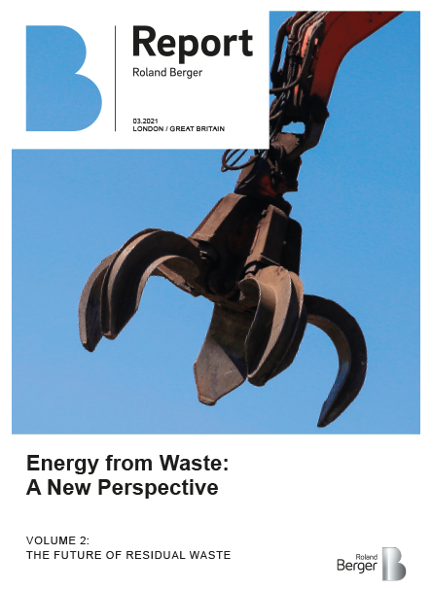Energy from Waste: A New Perspective
![{[downloads[language].preview]}](https://www.rolandberger.com/publications/publication_image/723_roland_berger_energy_from_waste_cover_download_preview.png)
How future recycling rates and arisings growth will impact the residual waste available for Energy from Waste in 2035


As Energy from Waste (EfW) infrastructure continues to attract significant investment and appears to be a key pillar of England's waste strategy, the supply of addressable residual waste is set to decline. EfW addressable residual waste in England looks to decrease meaningfully by 2035 mostly due to expected improvement in waste recycling rates. Under our median recycling rate scenario a decline in residual waste of 8% is expected. Under this scenario, we expect implementation of some form of a deposit return scheme, extended producer responsibility, and separation and mandatory collection of food waste from households. While most regions will follow the national trend, the variances between areas may have significant consequence when it comes to understanding the catchment EfW capacity gap. In this second volume of our three-part series we provide our perspective on the residual waste forecast by region, an important consideration when assessing regional EfW investments.

Total household and commercial & industrial (C&I) waste arisings in England are expected to grow at 0.4% p.a. to 2035. The positive impact of population and economic growth is expected to partially offset changing consumer habits and improvements in material efficiency. However, it is recycling rate improvements that are expected to have a much greater impact on the residual waste available for incineration.
Recycling rates across Europe have risen with the implementation of landfill taxes, investment in recycling infrastructure, and introduction of waste management regulations such as Extended Producer Responsibility (EPR). In its "Resources and Waste Strategy for England" of 2018, England set out a municipal recycling rate target of 65% by 2035, a highly ambitious number that would require significant policy intervention and investment.
"In the median scenario, we anticipate a decline in residual waste across all regions and an 8% drop overall from 2019 to 2035."
Assessing total household and C&I waste arisings growth, future recycling rate scenarios and the resultant addressability of waste for incineration, we forecast the evolution of residual waste for EfW in England, on a regional basis.
As investors evaluate the commercial viability of their investments, it is crucial for them to assess the long-term EfW demand-supply dynamics and infrastructure capacity gap. As EfW facilities often have localised catchment areas, any meaningful assessment needs to extend this analysis to the level of the region or the catchment area of the EfW facility in consideration. In volume 2 of this three-part series, we address the future of residual waste:

![{[downloads[language].preview]}](https://www.rolandberger.com/publications/publication_image/723_roland_berger_energy_from_waste_cover_download_preview.png)
How future recycling rates and arisings growth will impact the residual waste available for Energy from Waste in 2035